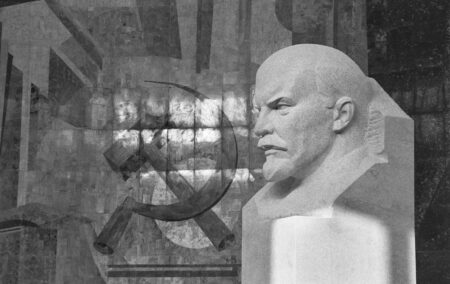One hundred years ago, Marxists died on a South African gallows defending white privilege. They sang The Red Flag as the trapdoors opened. Their revolutionary communist slogan was, “Workers of the World Unite, and Fight for a White South Africa!”
This was in 1922, five years after the Bolshevik Revolution in Russia, which these white workers supported (so did hardline Boers such as Barry Hertzog). Would Marx and Lenin have agreed with this slogan? So vague and contradictory is Marxist theory that they might have done.
Rand Revolt
The occasion was the Rand Revolt of 1922, by far the most violent workers’ insurrection in South African history. It happened on the Johannesburg gold mines. The cause was the intention of the mine owners to remove the colour bar and allow black miners to do the skilled jobs formerly reserved for whites. The white miners were outraged and frightened. Both owners and workers acted in logical self-interest. The owners wanted to maximise profits; this meant reducing costs, and the best way to reduce labour costs was to have a free market in labour, with black workers competing freely against whites. The white workers wanted to preserve their privilege and higher salaries.
Strike stoppages began on 10 Jan 1922. Within weeks, the white workers turned to armed rebellion, acquiring guns and setting up commandos. Strike-breakers were given police protection. Killings began at the end of February. The crowds became angrier and more violent. Jan Smuts, the Prime Minster, sent in troops to back up the police. In March a general strike was called. Innocent black people were murdered by the strikers. The rebels took over Brakpan and threatened Benoni, Fordsburg, and Brixton. The rebellion began to look like a revolution. Smuts sent in artillery and bomber aeroplanes. Over 200 people were killed, including policemen, and over 1 000 injured. Several rebels were eventually hanged, including four who died singing The Red Flag. By 18 March, the rebellion was crushed. It cast a long and dark shadow into South Africa’s future.
I believe the Rand Revolt planted the seeds of apartheid, which came 26 years later. Smuts lost popularity because of the way he dealt with the revolt, and was voted out and replaced as Prime Minister by Hertzog in 1924. A long, complicated and hard progress towards supreme power began among hardline Afrikaner nationalists who hated the English and therefore hated capitalism, which they associated with English imperialism. They had tremendous sympathy with the poor white working classes and believed strongly in racial segregation.
In November 1919, two years after Lenin’s revolution (actually a bourgeois coup, which had nothing to do with the working classes, although Hertzog didn’t seem to know that), Hertzog had said at a National Party conference that Bolshevism: “is the will of the people to be free, to rule itself and not to be the subject of a foreign conqueror. Why do they want to suppress and kill Bolshevism today? Because freedom of the people is death to capitalism and imperialism. Don’t let us be afraid of Bolshevism.”
Relationship
Both the Rand Revolt and apartheid illustrate in a most revealing way the relationships between the working classes and the bourgeoisie, capitalism and socialism, white and black. I have seen the same pattern, although less dramatic, in England and elsewhere. The most overtly racist whites are always the working classes, always among the least well paid. (The racism of the white bourgeoisie is covert.) The white workers in the Rand Revolt were quite open about their racism. The biggest supporters of apartheid were always the white working classes. The richer and more privileged you were as a white, the more likely you were to oppose apartheid. I found the same in England in the 1970s. When Enoch Powell began making his inflammatory speeches against black immigration (which he coyly called “New Commonwealth Immigration”), it split England by class. The white working classes cheered him to the man and marched to support him; the white bourgeoisie opposed him. If you read the Sun, you loved him; if you read the Guardian, you hated him. In about 1980, while I was working at a factory in Bury, north of Manchester, I once asked “Red Wilf”, a trade union leader, a militant socialist, a working-class hero, what he wanted the leader of the Labour Party to do if he became Prime Minister. He immediately gave a three-point program.
1. Take over the commanding heights of the economy.
2. Establish a universal free health service.
3. Expel all black immigrants. (These were not his actual words, which are unsuitable for this family newspaper.)
Colour blind
Raw capitalism is always colour blind. You employ people to increase your profits, so their competence matters and their skin colour doesn’t. Socialism is more interested in power and control and hierarchy than in making money, and sees people as belonging to groups, class or racial, rather than as individuals. Socialism has many forms including Communism, Fascism and National Socialism (Nazism) but all hate capitalism and all believe in collectives of one form or another. Apartheid was essentially a form of socialism based on race. When the hardline National Party finally came to power in 1948, it did institute racial job reservation, as promised, to protect the white workers, but it didn’t abolish capitalism altogether. Instead it controlled it and restricted it, and eventually strangled it.
The best account I have read of 1922 was Jeremy Krikler’s book, “The Rand Revolt: The 1922 Insurrection and Racial Killing in South Africa”. It is detailed and gripping. It is also rather sad as Krikler describes the personal tragedies of decent men caught up in it. This was a terrible event in our history and had terrible consequences.
The views of the writer are not necessarily the views of the Daily Friend or the IRR
If you like what you have just read, support the Daily Friend
Photo by Steve Harvey on Unsplash

